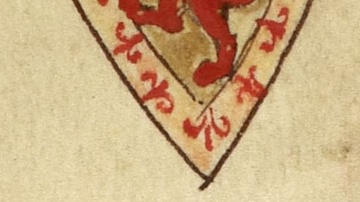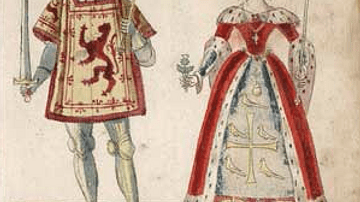The Isle of Skye, Scotland, is a land of myth, legend, and swirling mists that easily transport a visitor through time. The history of the island goes back to the Neolithic Period, and it has been the site of many significant events but, when I think of Skye, its place in Scottish legend always comes first to mind.
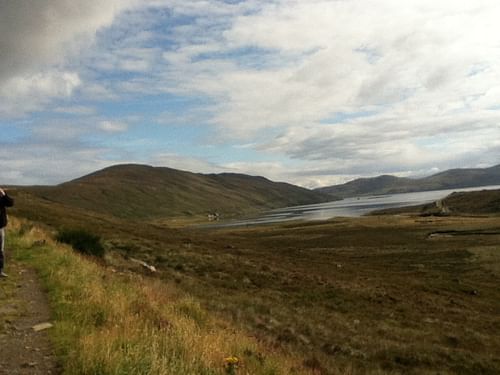
My wife Betsy, daughter Emily, and I traveled up from Edinburgh for a stay in Inverness one April and then went for the weekend over to Skye. After a visit to Eilean Donan Castle, we headed across the Skye Bridge. We would be staying at the Hotel Eilean Iarmain at the tip of the Sleat peninsula (“the Garden of Skye”) in the southern part of the island. The hotel was not far from the highland cities we had just left but felt separated from them by slowly tumbling strands of time and mist.
We traveled down a narrow, winding road from the bridge, singing the Skye Boat Song, through wild banks of heather and hills of rough rock and descended into a glen of scattered boulders and far-off sheep, passed over an ancient stone bridge, and into the village Eilean Iarmain: white-washed 19th-century buildings with black slate roofs perched by the sea at the very edge of the world. They had everything essential here: an art gallery, a whisky distillery and shop, a pub which served excellent food and glorious pints, a small clothing store, and the Ornsay Harbor stretching out quietly below the shadow of the mountains.
The Clearances
The hotel here dates from 1888 when it was an inn. At this time Skye would have been largely depopulated following the Highland Clearances in which landlords, looking to make even more money, had their tenants (known as “crofters”) evicted from lands they had farmed for generations and turned the fields to pasture for sheep farming. Highland farming had given way to a greater demand for wool and mutton and so a landlord could make a considerable sum switching their resources to sheep. This practice was fine enough for the landlords but not for the tenants. It is estimated some 20,000 crofters left Skye in 1775 alone.
The Clearances grew more intense and widespread following the Jacobite defeat by British forces at the Battle of Culloden on the mainland in 1746. Contrary to popular belief, the Clearances were not instituted by the British as a punishment for the Rising; the practice had been in place for almost 50 years prior to Culloden, instituted by Scottish landlords to maximize profit and minimize costs.
After Culloden, it is true, the Clearances became a means by which the British sought to destroy the Highland culture which had supported Bonnie Prince Charlie in the rebellion, but the oft-repeated tale that this was originally a British punitive policy is a myth. The Clearances continued, on and off, until the Crofters' Holding Act was passed in 1886, which made it illegal to remove crofters from their farms (known as crofts). By this time, however, the majority of the crofters had been expelled from the island or left on their own initiative and sheep farming and tourism had become the mainstays of business on Skye as people needing a break from city life were attracted by the natural wonders and stunning scenery.
Mists & Ghosts
Eilean Iarmain was built shortly after this act passed, catering to tourists from the mainland and offering a relaxing getaway from modern life on the mainland. The present hotel retains that sense of purpose in every way; the interior a comfortable and welcoming decor, soft chairs, deep wooden paneling, and a golden light as though from candles.
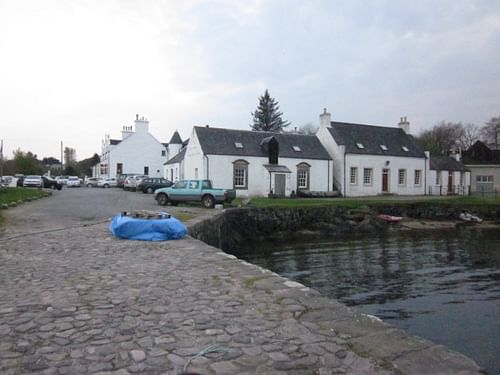
Once we checked in, Betsy walked out toward the water at low tide to the wreck of a small boat she wanted to explore and, slowly, seemed to disappear into a shifting fog. This might have been somewhat alarming, but Skye is referred to as the Island of the Mists; people and objects often seem to blink in and out of existence here. Skye, after all, is the setting for a number of mystical events a visitor might consider fiction but are understood as history by residents. Among these is the tale of the Fairy Princess who married a chief of Clan MacLeod but could only stay with him a year and a day before she vanished into the mists and returned to her own land. She left behind the Fairy Flag which is believed to have saved the Clan MacLeod from disaster a number of times throughout their history.
It is easy to imagine the Fairy Princess walking off into the mist and disappearing into another world. These silent mists come hovering toward dusk and transform the landscape. Here, as everywhere in Scotland, one finds the stray ruin of the old farmhouse, church, or castle. There are entire villages here which were completely abandoned during the Clearances, as one will find elsewhere in the Highlands, but the mists of Skye lift these from the earth to seemingly float in air or sometimes just vanish before your eyes.
Down the road from our hotel were the ruins of Knock Castle, dating from the 15th century, which we visited in the evening. The castle is untended, its broken walls rising from an outcrop of rocky hill overlooking a cove, and one must make a bit of effort to walk to it from the parking lot of Torabhaig distillery. Knock Castle is said to be haunted by a house spirit known as the Green Lady of the Clan MacDonald (who first built the fortress) as well as an earth spirit who once watched over their livestock and fields. When we first came up to the castle, floating in the mists, I could believe easily in both of them.
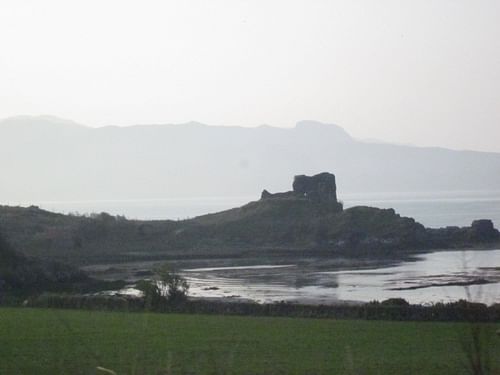
Armadale Castle
Knock Castle at twilight, silhouetted against the water, is like a scene from Arthurian romance. The castle is in complete ruin, though, and one should proceed with caution if visiting. A much safer site nearby is Armadale Castle, an impressive 19th-century ruin, and the later home of the MacDonald Clan. Flora MacDonald, famous for her rescue of Bonnie Prince Charlie following the Battle of Culloden, was married here. The castle is a part of the Armadale Castle Gardens & Museum of the Isles site, which also offers accommodations, a conference center, an excellent café located in the former stables, and a fascinating museum.
Armadale Castle alone is worth a visit to Skye. The 19th-century manor house rises in ruin from its site by the shore, tall empty windows opening in on bending trees and expanding vegetation. A small plaque outside the ruin shows the grand hall – which one would be standing in – at its height before fire took the building and it was abandoned. One cannot go into the castle but it is no matter; there is nothing to see inside one cannot see easily enough through the vacant windows and doorways.
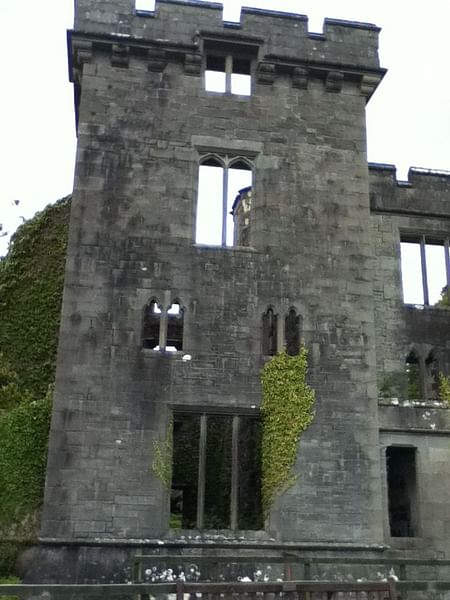
A wide lawn, brightly green, stretches down from the front of the castle to the shore. Gulls swoop down and strut like tightrope-walkers along the edge of the water and boats move slowly further out. Seemingly far away the mainland hovers in a fine mist like a mirage. Turning from this scene, one can walk back behind the castle to the gardens and up the hill to the museum which is a whole other kind of wonderful journey into the past.
The MacDonald Clan are still involved with the site, although they, like any of the Highland clans, struggled to maintain their traditional lands through the Clearances. The Scots are resilient folk, however, and many of the descendants who left for North America, New Zealand, or other ports eventually returned. Today there are those who live on or near the lands of their ancestors.
Sligachan Hotel & The Fairy Bridge
The next morning, we traveled north to Dunvegan Castle, a popular tourist attraction and the family seat of Clan MacLeod, ancient enemies of Clan MacDonald. You need a couple of days on Skye, though more, obviously, would be better. There is so much to see, and so much of it rewards a long stop at each site, that one could easily spend a month on this beautiful island and still not experience all it has to offer.
On the way to Dunvegan, we stopped in Sligachan to see the Black Cuillin Mountains and visit the Cuillin Brewery in the Sligachan Hotel. Among their many fine beers is the Red Cuillin and Black Cuillin, named for the nearby mountain ranges, and both excellent. They are best enjoyed at room temperature or with only a slight chill to them. The brewery is in the Sligachan Hotel whose Mackenzie’s Bar & Bistro serves breakfast, lunch, and dinner. The menu offers vegetarian and vegan options (a falafel burger or vegan chili) as well as all a carnivore could ask for such as sirloin steak or burgers. The coffee there is absolutely incredible. One should also leave room for dessert as offerings include toffee pudding, cheesecake, and apple crumble, all delicious. Seumas’ Bar, also in the hotel, serves pub food and has over 400 different malt whiskeys though it is not recommended you try them all at a sitting.
Near the hotel is the Old Sligachan Bridge which is pretty enough to look at but is a prime example of why you should know the history and mythology of Skye, and Scotland in general, before a visit because the structure is also known as the Fairy Bridge for the waters that run beneath it that are home to the “wee folk”, the fairies. The waters and their mystical inhabitants play a role in the legend of the great Scottish hero Cuchulainn and his battle with the warrior-witch Scathach.
There are a number of versions of the tale but, in one, Cuchulainn arrives on Skye to test his skills against the invincible Scathach. The two begin to fight and the whole island trembles as the battle continues throughout the day. Scathach’s daughter, knowing of Cuchulainn’s strength and skill, runs away to the stream, falls down, and begins crying because she fears her mother will be killed. The fairies feel her tears and hear her cries and comfort her, telling her to wash her face in the water and ask no questions. As soon as she washes her face, she understands how to stop the battle.
She hurries back toward her home at Dunscaith Castle, gathering herbs and nuts, and throws them onto the hearth fire, fanning the smoke so it blows across the land and reaches the two warriors, still locked in combat. Smelling the sweet scent of the herbs and nuts, both realized they had not eaten and were tired from their exertions. They followed the scent back to the castle where Scathach’s daughter had prepared a great feast. As Cuchulainn accepted the invitation to eat under Scathach’s roof, he became her guest and, according to the laws of hospitality, neither could take up arms against the other. After the meal, Cuchulainn became Scathach’s student and, in most versions, this was his reason for coming to Skye in the first place.
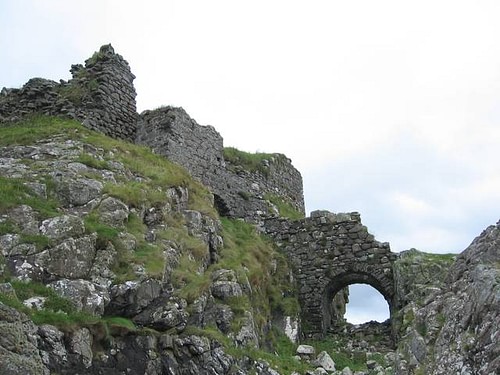
According to legend, the fairies still live in the waters beneath the bridge and grant the gift of eternal beauty to anyone who follows these simple rules exactly: You have to lay down on the bank of the stream and dip your face into the water. The water cannot be brought up to the face; the face has to be dipped into the water. You have to keep your face submerged for a full seven seconds (this may not sound very long but the water is incredibly cold). After seven seconds, you may stand up, but you cannot wipe the water from your face, it has to dry naturally, and afterwards you are granted eternal beauty.
I did not do the face-dipping, and neither did Emily, but Betsy did. I cannot say whether it worked because I always thought she was eternally beautiful beforehand, and she looked the same to me after our visit to the fairy stream.
Dunvegan Castle
According to legend, there is a ghost car that drives through Sligachan, a 1934 Austin Healy, whose driver is a minister who haunts the roads. We did not see him or his car, but perhaps this is because he only drives around after dark. We left Sligachan and drove about a half-hour toward the coast and Dunvegan Castle. This site is considered the oldest continuously occupied castle in northern Scotland. The area was originally occupied by the Norse who built a citadel there, which was expanded upon c. 1266 by the Clan MacLeod and the land and building further developed by later generations. The present castle, overall, dates from the 18th century, though some parts are obviously older.
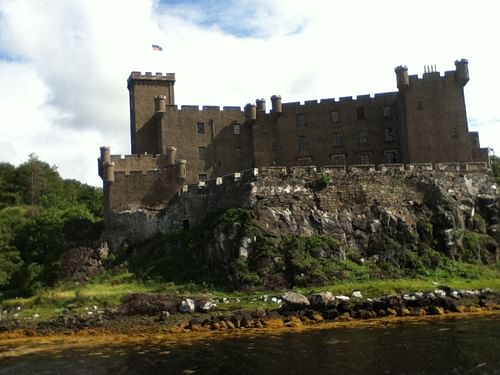
The castle and gardens are open to the public and one should really give one’s self a whole day there to enjoy everything leisurely, but we did not have that luxury. On the self-guided tour of the castle, you see all kinds of fantastic artifacts, but make sure to pause by the display case that holds the Fairy Flag. I overheard others saying they did not find the flag very impressive, and I thought this unwise. Although I cannot say with certainty that fairies exist, I prefer to err on the side of caution and not make them angry by insulting their flag. Another interesting artifact is the Dunvegan Cup, a drinking vessel of wood and ornamented with silver which also, according to legend, was a gift from the fairies. I recommend not insulting that piece either.
The gardens are spectacular and, we were told, are even more impressive in summer. Visitors meander through maze-like paths and over stone bridges, past waterfalls, with the castle close by and the scent of the sea on the breeze. There is a café near the parking area which is a popular spot where you can get soup, sandwiches, coffee, and snacks, and some people were sitting on benches in the gardens having a picnic. This seemed like fun, but again we were short on time and still had to make the drive back down south, so we left for the return trip.
Conclusion
The next day we visited Armadale Castle, already mentioned, and the ruins of Dunscaith Castle which are equally impressive. If you know the story of Cuchulainn and Scathach, a visit to Dunscaith is like stepping into a myth. Historically, the castle was built by Clan MacLeod in the 13th century but was later taken by Clan MacDonald in the course of the endless wars between the two. The castle was abandoned in the 17th century, and today is among the most picturesque ruins on Skye, looming on an outcrop of rock above the sea. It is not surprising that the site would give rise to the tale of the warrior-witch Scathach or any of the other myths associated with it. The castle is an untended ruin, open to the elements and although there are no artifacts on display, there is plenty to feel and sense at the site as well as stunning views of the Cuillin ranges far across the water.
Later that day, after further exploration, we returned to the hotel to relax. It is easy enough to see why one would need to return to Skye. The island has an otherworldly, fierce beauty to it with the sound and scent of the sea and the green-yellow and brown-gray cliffs rising up in the distances. That evening, sitting outside the 'Am Praban Bar at the Hotel Eileen Iarmain at sunset, the gulls wheeled and cried overhead, and the sound of a guitar and fiddle started up from behind the pub’s windows as someone began to sing.
Thoughts of the past came to mind and the families who were forced to leave and the people who never returned to their homes here. You can almost see them all there before you, boarding the boats in the small harbor; but then the air seems to shift, and the vision clears, and you are back in the present hearing a man singing as the fiddle tune rises above the quick rhythm of the guitar.
The mists move slowly over the harbor, veiling the far hills, then approaching closer to take your hand and invite you to remember those of the past in a bit of celebration. The music suddenly sounded louder from the bright windows of the pub and I decided to go make some more memories of the Isle of Mists by finding Betsy and Emily, raising a pint, and joining in the song.

